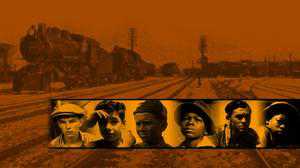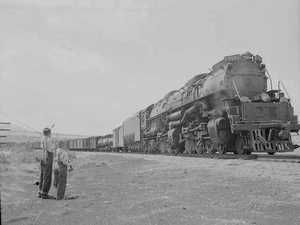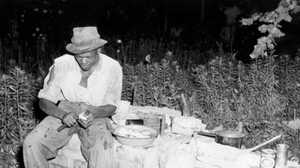Riding the Rails Timeline

October 1929
The stock market crashes, marking the end of six years of unparalleled prosperity for most sectors of the American economy. On October 24 -- Black Thursday -- stock prices plummet and panic selling ensues as people try to sell stock for any price they can get. By October 29 -- Black Tuesday -- stocks will completely collapse and banks will be calling in loans. An estimated $30 billion in stock values will "disappear" by mid-November.
November 1929
President Herbert Hoover says, "Any lack of confidence in the economic future or the basic strength of business in the United States is foolish."
March 1930
More than 3.2 million people are unemployed, up from 1.5 million before the October, 1929 crash. President Hoover remains optimistic, however, stating that "all the evidences indicate that the worst effects of the crash upon unemployment will have passed during the next 60 days."
November 1930
The street corners of New York City are crowded with apple-sellers. Nearly 6,000 unemployed individuals work at selling apples for five cents apiece.
January 1931
Texas congressman Wright Patman introduces legislation authorizing immediate payment of "bonus" funds to veterans of World War I. The "bonus bill" had been passed in 1924. It allots bonuses, in the form of "adjusted service certificates," equaling $1 a day for each day of service in the U.S., and $1.25 for each day overseas. President Hoover is against payment of these funds, saying it would cost the Treasury $4 billion.
February 1931
"Food riots" begin to break out in parts of the U.S. In Minneapolis, several hundred men and women smash the windows of a grocery market and make off with fruit, canned goods, bacon, and ham. One of the store's owners pulls out a gun to stop the looters, but is leapt upon and has his arm broken. The "riot" is brought under control by 100 policemen. Seven people are arrested.
Resentment of "foreign" workers increases along with unemployment rolls. In Los Angeles, California, Mexican Americans are accused of stealing jobs from "real" Americans. During the month, 6,024 Mexican Americans are deported.
December 1931
New York's Bank of the United States collapses. At the time of the collapse, the bank had over $200 million in deposits, making it the largest single bank failure in the nation's history.
January 1932
Congress establishes the Reconstruction Finance Corporation. The R.F.C. is allowed to lend $2 billion to banks, insurance companies, building and loan associations, agricultural credit organizations and railroads. Critics of the R.F.C. call it "the millionaires' dole."
March 1932
Three thousand unemployed workers march on the Ford Motor Company's plant in River Rouge, Michigan. Dearborn police and Ford's company guards attack the workers, killing four and injuring many more.
April 1932
More than 750,000 New Yorkers are reported to be dependent upon city relief, with an additional 160,000 on a waiting list. Expenditures average about $8.20 per month for each person on relief.
May 1932
More than 300 World War I veterans leave Portland, Oregon en route to Washington, D.C. to urge Congress to pass the Bonus Bill. It will take them 18 days to reach Washington, D.C.
June 1932
Determined to collect their "bonus" pay for service, 15,000 - 25,000 World War I veterans gather and begin setting up encampments near the White House and the Capitol in Washington, D.C. On June 15, the House passes Congressman Wright Patman's "bonus bill" by a vote of 209 to 176. The bill falls to defeat in the Senate, however, 62 to 18. The vets maintain their determination to stay camped out until they get their pay.
July 1932
The Reconstruction Finance Corporation is authorized to lend needy states sums from the National Treasury. The money is to target relief and public works projects.
President Hoover signs a $100,000 transportation bill to assist "bonus Army" demonstrators in getting home. He sets a July 24 deadline for the men to abandon their encampments.
On July 28, when some "bonus Army" members resist being moved from their camps, violence erupts, leading to the deaths of two veterans. Hoover orders Federal troops, under the command of General Douglas MacArthur, to assist D.C. police in clearing the veterans.
November 1932
Franklin Delano Roosevelt is elected president in a landslide over Herbert Hoover. Roosevelt receives 22.8 million popular votes to Hoover's 15.75 million.
March 1933
Before a crowd of 100,000 at the Capitol Plaza in Washington, D.C., Franklin Delano Roosevelt is inaugurated. FDR tells the crowd, "The people of the United States have not failed. In their need they have registered a mandate that they want direct, vigorous action. They have asked for discipline and direction under leadership. They have made me the present instrument of their wishes. In the spirit of the gift I take it."
FDR announces a four-day bank holiday to begin on Monday, March 6. During that time, FDR promises, Congress will work on coming up with a plan to save the failing banking industry.
By March 9, Congress passes the Emergency Banking Act of 1933. By month's end, three-quarters of the nation's closed banks will be back in business.
On March 12, FDR delivers the first of what came to be known as his "fireside chats." In his initial "chat" he appeals to the nation to join him in "banishing fear."
April 1933
President Roosevelt, under the Emergency Banking Act, orders the nation off of the gold standard.
The Civilian Conservation Corps (CCC) is established. Designed as a relief and employment program for young men between the ages of 17 and 27, the CCC is made up of groups of young men who work in national forests, parks, and federal land for nine-month stints. FDR envisions the program as a kind of volunteer "army." The first 250,000 young men are housed in 1,468 camps around the country. At its peak in 1935, the CCC will include 500,000 young men.
May 1933
The Federal Emergency Relief Administration is created by Congress. President Franklin Roosevelt appoints Harry L. Hopkins as its chief administrator. By the end of his first day on the job, Hopkins has issued grants totaling more than $5 million.
The National Industrial Recovery Act is introduced into Congress. Under Title I of the act, the National Recovery Administration is designated to maintain some form of price and wage controls. Section 7(a) of the act guarantees labor the right to organize and bargain collectively. As part of the act, The National Labor Board is set up to negotiate disputes between labor and management.
The Tennessee Valley Authority is created. A federally run hydroelectric power program, the TVA Act is considered a huge experiment in social planning. The TVA also builds dams, produces and sells fertilizer, reforests the Tennessee Valley area, and develops recreational lands. Opponents of the TVA call it "communistic to its core."
June 1933
Congress passes the Glass-Steagall Act that separates commercial from investment banking and sets up the Federal Deposit Insurance Corporation to guarantee bank deposits.
August 1933
With an eye toward organizing farmers into soil conservation districts, the federal government establishes the Soil Erosion Service. The creation of this service was made necessary by the years of drought and dust that plagued the Southwestern Panhandle states.
September 1933
In an effort to stabilize prices, the Federal Agricultural Program orders the slaughter of more than 6 million pigs. Many citizens protest this action since most of the meat went to waste.
October 1933
The Civil Works Administration is established. Devised as a wide scale program that could employ up to 4 million people, the C.W.A. is involved in the building of bridges, schools, hospitals, airports, parks and playgrounds. Additionally, C.W.A. funds go toward the repair and construction of highways and roads. Early in 1934, Congress will authorize $950 million for the continued operation of the C.W.A.
May 1934
A three-day dust storm blows an estimated 350 million tons of soil off of the terrain of the West and Southwest and deposits it as far east as New York and Boston. Some east coast cities are forced to ignite street lamps during the day to see through the blowing dust.
November 1934
Father Charles E. Coughlin establishes the Union for Social Justice. Using the radio airwaves as his pulpit, Father Coughlin railes against "predatory capitalism." His criticism of the banking industry and disdain of communism soon dovetails into a troubling gospel of anti-Semitism.
April 1935
FDR signs legislation creating the Works Progress Administration. (Its name would be changed in 1939 to the Work Projects Administration.) The program employs more than 8.5 million individuals in 3,000 counties across the nation. These individuals, drawing a salary of only $41.57 a month, will improve or create highways, roads, bridges, and airports. In addition, the WPA will put thousands of artists -- writers, painters, theater directors, and sculptors -- to work on various projects. The WPA will remain in existence until 1943.
Business Week magazine announces that "Depression is a forgotten word in the automobile industry, which is forging ahead in production, retail sales, and expansion of productive capacity in a manner reminiscent of the 'twenties.'"
June 1935
The National Youth Administration is set up to address the needs of young men and women (who are not allowed in the CCC). The NYA works on two levels: a student-work program and an out-of-school program. The student-work program provides students with odd jobs that pay them enough to stay in school. The out-of-school program sets young people up with various jobs ranging from house painting to cleaning local parks, and eventually comes to include vocational training.
July 1935
FDR signs the Wagner National Labor Relations Act. The goal of the act is to validate union authority and supervise union elections.
August 1935
The Social Security Act of 1935 is signed into law by FDR. Among the most controversial stipulations of the act is that Social Security will be financed through a payroll tax. Historian Kenneth S. Davis calls the signing of the act "one of the major turning points of American history. No longer could `rugged individualism' convincingly insist that government, though obliged to provide a climate favorable for the growth of business profits, had no responsibility whatever for the welfare of the human beings who did the work from which the profit was reaped."
March 1936
Photographer Dorothea Lange visits a pea-pickers' camp in California's San Joaquin Valley and takes photographs of harvest workers. The images, especially those in the "Migrant Mother Series," vividly illustrate the plight of the workers. The San Francisco News runs the photo essay under the headline, "Ragged, Hungry, Broke, Harvest Workers Live in Squallor (sic)."
October 1936
The San Francisco News publishes a series of articles written by John Steinbeck called "The Harvest Gypsies." The series explores the hardships faced by those living and working in migrant labor camps. Steinbeck writes, "...One has only to go into the squatters' camps where the families live on the ground and have no homes... to look at the strong purposeful faces, often filled with pain... to know that this new race is here to stay and that heed must be taken of it."
November 1936
Defeating Kansas Governor Alfred M. Landon, FDR is elected to his second term as president, winning every state in the Union except Maine and Vermont.
January 1937
United Automobile Workers strike at the General Motors Plant in Flint, Michigan. The strike turns violent when strikers clash with company-hired police.
March 1937
The slow economic recovery made possible by New Deal programs suffers a setback as unemployment rises. FDR's detractors call it the start of the "Roosevelt recession."
May 1937
At Republic Steel's South Chicago plant, workers and their families try to combine a picnic with a rally and demonstration. Ten people are killed and a dozen more are wounded in the "Memorial Day Massacre."
April 1938
FDR asks Congress to authorize $3.75 billion in federal spending to stimulate the sagging economy. Economic indicators respond favorably over the next few months. Still, unemployment will remain high and is predicted to stay that way for some time.
November 1940
Franklin Roosevelt is elected to an unprecedented third term as president, defeating Wendell Willkie. FDR's victory is seen as proof of the nation's support of his war policies. Roosevelt lobbies Congress to pass the Lend-Lease Act, which will aid Britain in its struggle to fend off Germany.
In little over a year, following Japan's December 1941 bombing of Pearl Harbor, the U.S. will enter the war in the Pacific and in Europe. The war effort will jump-start U.S. industry and effectively end the Great Depression.








